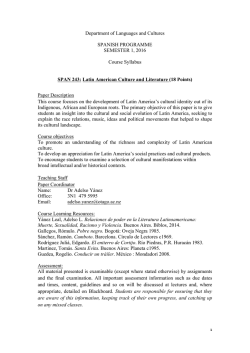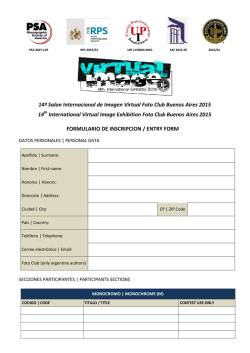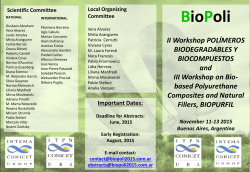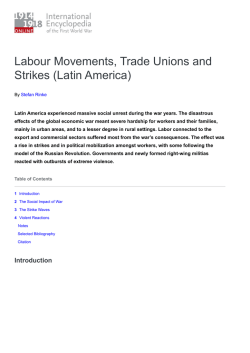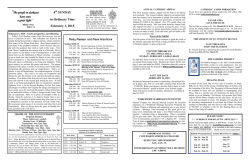
SCIENTIFIC NOTE - Universidad de Buenos Aires
Journal of the American Mosquito Control Association, 31(3):271–274, 2015 Copyright E 2015 by The American Mosquito Control Association, Inc. SCIENTIFIC NOTE FIRST RECORD AND LARVAL HABITAT DESCRIPTION OF CULEX (MELANOCONION) PILOSUS FROM BUENOS AIRES PROVINCE, ARGENTINA JUAN IGNACIO URCOLA AND SYLVIA FISCHER Grupo de Estudio de Mosquitos, Departamento de Ecologı́a, Genética y Evolución, and IEGEBA (UBA-CONICET), Facultad de Ciencias Exactas y Naturales, Universidad de Buenos Aires, C1428EGA Buenos Aires, Argentina ABSTRACT. Larvae of Culex (Melanoconion) pilosus were collected during February–April 2014 in temporary pools in ‘‘Bosques de Ezeiza,’’ a large forested park, near Buenos Aires city, Argentina. This is the first record in Buenos Aires Province, extending the distribution of this species 380 km to the south. Regarding habitat use, Cx. (Mel.) pilosus is a generalist, although a slight association of larval abundances with pools of lower pH and higher vegetation cover was observed. The comparison of larval instars of Cx. (Mel.) pilosus with those of other genera suggests a life-history strategy similar to that of floodwater mosquitoes. KEY WORDS Distribution, environmental variables, Ezeiza, larval habitat, larval instars The distribution of Culex (Melanoconion) pilosus (Dyar and Knab) extends from the southeastern United States to the central region of Argentina. This species has been recorded in all the countries of the American continent, except for Greenland, Canada, some Caribbean islands, Chile, and Uruguay (Marquetti-Fernández et al. 2013, WRBU 2014). In Argentina, Cx. (Mel.) pilosus has been reported for different sites in the northeastern and central regions, in the provinces of Chaco, Corrientes, Misiones, Santa Fe, Formosa, and Córdoba, all within the phytogeographic regions of Chaco, Espinal, and Paranaense (Pires et al. 2009). The larvae of Cx. (Mel.) pilosus develop in permanent and semipermanent pools, ditches, floodwater areas, grassy pools, streams, and occasionally in artificial containers (Carpenter and LaCasse 1955), generally with clear water, abundant vegetation, and fully exposed to sunlight (Pecor 2000, Pires et al. 2009). Females lay drought-resistant eggs individually either in or on moist substrata (Galindo et al. 1951, Stone and Haeger 1970, Castro Gomes et al. 1998). These eggs resist hatching and remain viable for at least 1 month under moist conditions (Galindo et al. 1951) and hatch upon being flooded (Stone and Haeger 1970). In this study, we report the first record of Cx. (Mel.) pilosus for Buenos Aires Province and provide information on its larval habitat characteristics in this region. The study area, Bosque de Ezeiza (34u469070S, 58u329500W), extends over 450 ha at the edge of the metropolitan area of Buenos Aires, in the transition between an urban and rural landscape. The climate is temperate humid, with seasonally varying temperatures (winter mean: 10uC, summer mean: 23uC). The average annual rainfall is 1000 mm, and rainfall events are recorded throughout the year (Atlas Ambiental de Buenos Aires 2010). Most of the area of Bosque de Ezeiza is covered by planted Eucalyptus sp., and the irregular relief of the land favors the formation of several temporary pools after rainfall events. During a study of the aquatic macro-invertebrate communities present in Bosque de Ezeiza, 12 temporary pools were surveyed every 2 wk from October 2013 to April 2014. On each sampling date, the maximum depth, water temperature, pH, surface area, exposure to sun, and vegetation cover were assessed. Samples of mosquito larvae were taken with a hand net (10 3 12 cm, mesh size 350 mm), and for each pool, the sampling effort was approximately proportional to the surface covered by water. Samples were fixed in situ in 80% alcohol. Immature mosquitoes were separated by stage and identified under a stereoscopic microscope with the use of appropriate systematic keys (Darsie 1985). Voucher specimens of each species were deposited in the Diptera collection of the Museo Argentino de Ciencias Naturales Bernardino Rivadavia. The number of individuals of Cx. (Mel.) pilosus, Ochlerotatus spp. (5 Aedes (Ochlerotatus) spp., Reinert 2000), and Cx. (Culex) spp. of each larval instar was recorded. Only the dates when Cx. (Mel.) pilosus larvae were recorded were considered for the following analyses. The relative frequency of the different larval instars of this species was compared with the relative frequency of larval instars of Cx. (Cx.) sp. and Ochlerotatus sp. A principal component analysis (PCA) of the environmental variables (maximum depth, water temperature, pH, surface area, exposure to sun, and vegetation cover) in each sample (pool by date) was performed, and the abundance of Cx. (Mel.) pilosus larvae was included as a supplementary variable. 271 272 JOURNAL OF THE AMERICAN MOSQUITO CONTROL ASSOCIATION VOL. 31, NO. 3 Fig. 1. Relative frequency of different larval instars of Culex (Melanoconion) pilosus, Culex spp., and Ochlerotatus spp. on four different dates (a, b, c, d). In total, 784 Cx. (Mel.) pilosus larvae were collected from February to April 2014, on four sampling dates with relatively high temperatures (average air temperatures of the week previous to sampling between 19uC and 23uC). Individuals of Cx. (Mel.) pilosus were collected in all the pools studied, where they coincided with other mosquito species: Oc. albifasciatus (Macquart) (5 Aedes albifasciatus, Reinert et al. 2005, 2009), Oc. crinifer (Theobald) (5 Aedes crinifer, Reinert et al. 2005), Psorphora ferox (Von Humboldt), Ps. ciliata (F.), Ps. cyanescens (Coquillett), Cx. (Cx.) pipiens L., Cx. (Cx.) eduardoi Casal and Garcı́a, and Cx.(Cx.) tatoi Casal and Garcı́a. The development of larvae of Cx. (Mel.) pilosus was generally more advanced than that of larvae of Cx. (Cx.) spp. (Fig. 1a–1d), similar to that of larvae of Ochlerotatus spp. on two sampling dates (Fig. 1b, 1d), and slightly less advanced than that of Ochlerotatus spp. on one sampling date (Fig. 1c). Culex (Mel.) pilosus individuals were recorded in pools within a narrow range of pH values (6.28 to 7.64) and vegetation cover (high), but within a wide range of surface areas (1.12 to 324 m2), maximum depths (4 to 40 cm), and exposure to sun (low to high). The two first components of the PCA explained 54.1% of the environmental variability measured. The first component showed a negative correlation with water temperature, maximum depth, surface area, and exposure to sun, whereas the second component showed a positive correlation with pH, and a negative correlation with vegetation cover (Fig. 2). The abundance of Cx. (Mel.) pilosus showed no correlation with the first component and a low negative correlation with the second component. The graph of the scores of the samples (pools by dates) on the two components shows that most of the samples with Cx. (Mel.) pilosus are concentrated over the negative values of the second component (associated with lower pH values and higher vegetation cover). In contrast, samples without this species were concentrated on the positive region of the second component (Fig. 2). This is the first record of this species in the Pampean phytogeographic region, although the area planted with Eucalyptus sp. in the study area represents an important difference from the usual grassland or agricultural landscape of this region. However, the fact that larvae were collected more than once and in all the pools studied suggests that this species might be a common inhabitant of temporary pools in the study area. The presence of Cx. (Mel.) pilosus was recorded during the period of highest temperatures both in Buenos Aires (this study) and in Córdoba (Pires et al. 2009). This suggests that in the temperate region of Argentina, this species is limited to the warm season, in contrast with the findings in Chaco Province, in the tropical region of Argentina, where this species is found throughout the year (Stein et al. 2004). Both the observation of more advanced instars of Cx. (Mel.) pilosus larvae than of those of Cx. (Cx.) spp. larvae and their similarity with the larval instars of Ochlerotatus spp. suggest that this species has a lifehistory strategy similar to that of floodwater mosquitoes, in agreement with the previous reports of drought-resistant eggs. The lack of SEPTEMBER 2015 Scientific Note 273 Fig. 2. Sample scores on the two principal components of samples with and without Culex (Melanoconion) pilosus larvae. The size of the circles indicates larval abundance in the corresponding sample. Inset: Correlation of environmental variables (T, temperature; D, depth; S, pool surface area; I, insolation; V, vegetation; and pH) with the two principal components. a clear relation of larval abundance with the environmental variables studied suggests a generalist use of habitat of this species within the range of conditions studied, and this is consistent with the previous observations of this species in a wide range of aquatic environments (Carpenter and LaCasse 1955, Pecor et al. 2000, Pires et al. 2009, Stein et al. 2011). The collected material represents the most southern record for Cx. (Mel.) pilosus, and it extends the distribution range of this species more than 380 km to the southeast of its previous limit in Argentina. We thank Raúl Campos, Instituto de Limnologia ‘‘Dr. Raúl Ringuelet’’ – Consejo Nacional de Investigaciones Cientificas y Técnicas (ILPLACONICET) for confirming the identification of Cx. (Mel.) pilosus larvae, and two anonymous reviewers for their comments, which improved the quality of the manuscript. Air temperature data were provided by the Servicio Meteorológico Nacional of Argentina. This study was partly supported by grant PICT 1254-2012, Fondo para la Investigación Cientifica y Tecnológica (FONCyT). REFERENCES CITED Atlas Ambiental de Buenos Aires. 2010. Unidades Temáticas, Aire, Clima [Internet]. [accessed 20 October 2014]. Available from: http://atlasdebueno saires.gov.ar. Carpenter SJ, LaCasse WJ. 1955. Mosquitoes of North America (north of Mexico). Berkeley, CA: Univ. California Press. Castro Gomes A, Bernadete E, Mureb MA, Teixeira M, Machado JP, Silva IJ. 1998. Obsercão sobre caracterı́stica natural de oviposição de Culex (Melanoconion) Grupo pilosus (Diptera: Culicidae). Rev Saúde Pública 32:370–371. Darsie RF Jr. 1985. Mosquitos of Argentina. Part I. Keys for identification of adult female and fourth stage larvae in English and Spanish (Diptera: Culicidae). Mosq Syst 17:153–253. Galindo P, Carpenter SJ, Trapido H. 1951. Ecological observations on forest mosquitoes of an endemic yellow fever area Panama. Am J of Trop Med Hyg 31:98–137. Marquetti-Fernández MC, Saint-Jean Y, Fuster-Callaba CA, Gonzalez-Broche R, Leyva M. 2013. Contribución al conocimiento de la distribución y aspectos biológicos de algunas especies de mosquitos de Haitı́. Anales de Biologı́a 35:55–63. Pecor JE, Jones J, Turrell MJ, Fernandez R, Carbajal F, O’Guinn M, Sardalis M, Watts D, Zyzak M, Calampn C, Klein TA. 2000. Annotated checklist of the mosquito species encountered during arboviral studies in Iquitos, Peru. J Am Mosq Control Assoc 16:210–218. Pires DA, Laurito M, Almiron W, Gleiser RM. 2009. First record of Culex (Melanoconion) pilosus from Córdoba City, Argentina. J Am Mosq Control Assoc 25:206–207. Reinert JF. 2000. New classification of the composite genus Aedes (Diptera: Culicidae: Aedini), elevation of the subgenus Ochlerotatus to generic rank, reclassification of the other subgenera, and notes on certain subgenera and species. J Am Mosq Control Assoc 16:175–188. Reinert JF, Harbach RE, Kitching IJ. 2009. Phylogeny and classification of the tribe Aedini (Diptera: Culicidae). Zool J Linn Soc 157:700–794. 274 JOURNAL OF THE AMERICAN MOSQUITO CONTROL ASSOCIATION Reinert JF, Harbach RE, Sallum MAM. 2005. Checklist of aedine mosquito species (Diptera, Culicidae, Aedini) occurring in Middle and South America (south of the United States) reflecting current generic and subgeneric status. Rev Bras Entomol 49:249–252. Stein M, Almiron WR, Willener JA, Gorodner JO. 2004. Variación temporal de formas inmaduras de mosquitos (Diptera: Culicidae) en la Provincia del Chaco. Comun Cient Tecnol UNNE B-043. Resistencia. Universidad Nacional del Nordeste. Available from: http://www.unne.edu.ar/Web/cyt/com2004/6Biologia/B-043.pdf. VOL. 31, NO. 3 Stein M, Ludueña-Almeida F, Willener JA, Almirón WR. 2011. Classification of immature mosquito species according to characteristics of the larval habitat in the subtropical province of Chaco, Argentina. Mem Inst Oswaldo Cruz 106:400–407. Stone A., Haeger JS. 1970, Status of Culex subgenera Melanoconion and Mochlostyrax. Mosq Syst 2:37–38. WRBU [Walter Reed Biosystematics Unit]. 2014. Systematic Catalog of Culicidae [Internet]. Washington, DC: Smithsonian Institution [accessed 20 November 2014]. Available from: http://www.mosquitocatalog.org/ main.asp.
© Copyright 2025
